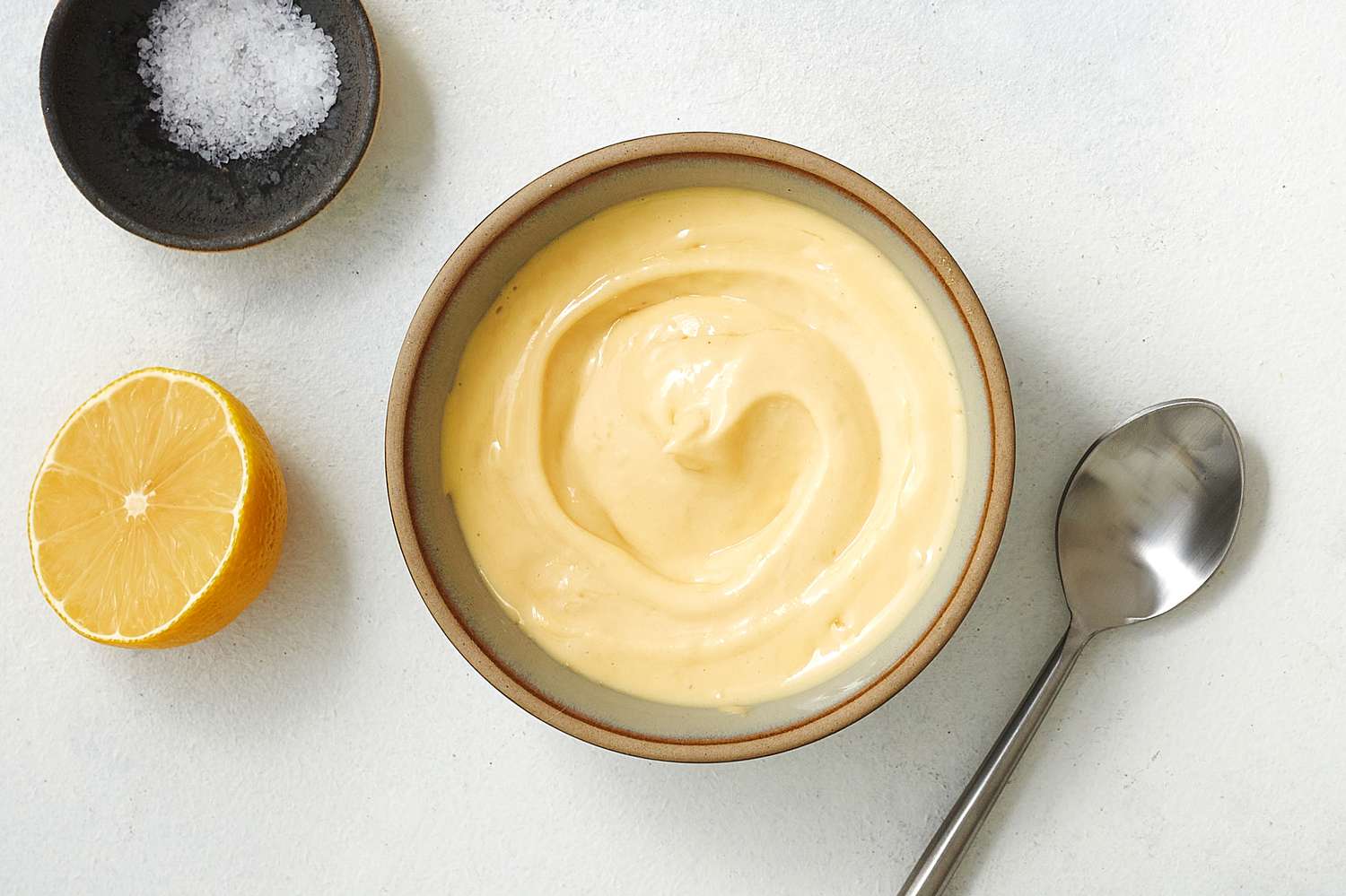Creating your own mayonnaise at home is a simple and rewarding process. This creamy and tangy condiment can elevate any dish, from sandwiches to salads. With just a few basic ingredients, you can whip up a batch of fresh, homemade mayonnaise in no time.
One ingredient you might not always have on hand is dijon mustard. This type of mustard is known for its smooth texture and slightly spicy flavor, which adds depth to the mayonnaise. If you don't have it, you can usually find it in the condiment aisle of your local supermarket. Additionally, make sure your egg is at room temperature to ensure proper emulsification.

Ingredients For Mayonnaise Recipe
Vegetable oil: This is the base of the mayonnaise and provides the creamy texture.
Egg: Acts as an emulsifier to combine the oil and other ingredients.
Lemon juice: Adds acidity and a fresh, tangy flavor.
Dijon mustard: Provides a slight kick and helps stabilize the emulsion.
Salt: Enhances the overall flavor of the mayonnaise.
Technique Tip for This Recipe
To ensure your mayonnaise emulsifies properly, make sure all your ingredients are at room temperature. This helps the egg and oil blend together more smoothly, creating a stable mixture. Additionally, when adding the oil, do so in a very slow and steady stream. This gradual incorporation is key to achieving the right consistency and preventing the mixture from breaking.
Suggested Side Dishes
Alternative Ingredients
vegetable oil - Substitute with olive oil: Olive oil provides a richer flavor and is a healthier option due to its monounsaturated fats.
vegetable oil - Substitute with avocado oil: Avocado oil has a neutral taste and high smoke point, making it a great alternative for emulsification.
egg - Substitute with aquafaba: Aquafaba, the liquid from canned chickpeas, can mimic the emulsifying properties of eggs, making it suitable for a vegan option.
egg - Substitute with silken tofu: Silken tofu can be blended to a smooth consistency, providing a similar texture and binding properties as eggs.
lemon juice - Substitute with apple cider vinegar: Apple cider vinegar offers a similar acidity and tanginess, which helps in emulsifying the mayonnaise.
lemon juice - Substitute with white wine vinegar: White wine vinegar has a mild flavor and acidity that can effectively replace lemon juice in the recipe.
dijon mustard - Substitute with yellow mustard: Yellow mustard can provide a similar tangy flavor and help in the emulsification process.
dijon mustard - Substitute with whole grain mustard: Whole grain mustard adds a slightly different texture and a robust flavor while still aiding in emulsification.
salt - Substitute with sea salt: Sea salt can be used as a direct replacement, offering a similar salty taste with potentially more minerals.
salt - Substitute with kosher salt: Kosher salt has larger crystals and a cleaner taste, making it a good alternative for seasoning.
Other Alternative Recipes
How to Store or Freeze Your Dish
- Store your freshly made mayonnaise in an airtight container to maintain its creamy texture and prevent it from absorbing any unwanted odors from the fridge.
- Keep the container in the coldest part of your refrigerator, typically the back, to ensure it stays fresh for up to one week.
- If you notice any separation or liquid forming on top, simply give it a gentle stir to reincorporate the ingredients.
- For those who love to plan ahead, freezing mayonnaise is an option, though it may alter the texture slightly. To freeze, transfer it to a freezer-safe container, leaving some space at the top for expansion.
- Label the container with the date to keep track of its freshness, and use it within two months for the best quality.
- When ready to use, thaw the mayonnaise in the refrigerator overnight. Once thawed, give it a good stir to bring back its smooth consistency.
- Avoid refreezing mayonnaise after it has been thawed, as this can further affect its texture and flavor.
- Always use clean utensils when scooping out mayonnaise to prevent contamination and extend its shelf life.
How to Reheat Leftovers
- Gently whisk the mayonnaise to restore its creamy texture before using it.
- Avoid microwaving as it can cause the egg to cook and the oil to separate.
- If the mayonnaise has thickened too much, stir in a few drops of lemon juice or vinegar to loosen it up.
- For a slight warmth, place the mayonnaise in a heatproof bowl and set it over a pot of simmering water, stirring constantly until it reaches the desired temperature.
- Always reheat only the amount you need to avoid repeated temperature changes, which can affect the quality and safety of the mayonnaise.
Best Tools for This Recipe
Blender: A blender is essential for combining the ingredients and ensuring they emulsify properly.
Measuring cup: Use a measuring cup to accurately measure 1 cup of vegetable oil.
Measuring spoons: Measuring spoons are necessary for measuring the lemon juice, mustard, and salt precisely.
Spatula: A spatula helps in scraping down the sides of the blender to ensure all ingredients are well incorporated.
Small bowl: A small bowl can be used to crack the egg into before adding it to the blender, ensuring no shell pieces get in.
Spoon: A spoon is useful for tasting and adjusting the seasoning with salt.
How to Save Time on This Recipe
Use a food processor: A food processor can blend ingredients faster than a blender, saving you time.
Room temperature ingredients: Ensure the egg is at room temperature to help the mayonnaise emulsify quicker.
Pre-measure ingredients: Measure out the vegetable oil, lemon juice, and dijon mustard before starting to streamline the process.
Steady oil stream: Pour the oil in a thin, steady stream to avoid breaking the emulsion, which can save time on fixing mistakes.
Use a squeeze bottle: Transfer the mayonnaise to a squeeze bottle for easy storage and quick access.

Mayonnaise Recipe
Ingredients
Main Ingredients
- 1 cup Vegetable Oil
- 1 large Egg at room temperature
- 1 tablespoon Lemon Juice freshly squeezed
- 1 teaspoon Dijon Mustard
- ½ teaspoon Salt
Instructions
- 1. In a blender, combine egg, lemon juice, and mustard.
- 2. Blend on medium speed until combined.
- 3. With the blender running, slowly add the oil in a steady stream.
- 4. Blend until the mixture thickens and emulsifies.
- 5. Season with salt to taste.
Nutritional Value
Keywords
More Amazing Recipes to Try 🙂
- Egg Rolls Recipe50 Minutes
- Air Fryer Meatballs Recipe25 Minutes
- Roasted Pork Banh Mi Recipe1 Hours
- Grilled Turkey Reuben Sandwich Recipe20 Minutes
- Grilled Cheese de Mayo Recipe15 Minutes
- Cuban Midnight Sandwich Recipe20 Minutes
- Hot Shredded Chicken Sandwiches Recipe30 Minutes
- Funeral Sandwiches Recipe35 Minutes


Leave a Reply